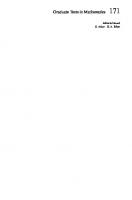Principal Directions in a Riemannian Space
352 49 683KB
English Pages 6 Year 1922
Recommend Papers
File loading please wait...
Citation preview
MA THEMA TICS: J. L. SYNGE
198
PROC. N. A. S.
PRINCIPAL DIRECTIONS IN A RIEMANNIAN SPACE By J. L. SYNGE DZPARTMSNT OF MATHZMATICS, UNIVERSITY OF TORONTO Communicated, May 23, 1922
1. A type of principal directions for a Riemannian space of N dimensions has been defined by Ricci (Atti R. Ist. Veneto, 63, p. 1233). Four distinct types are defined in the present paper, of which one is identical with that of Ricci, although defined in a manner somewhat more simple. We shall adopt the common convention of summation with respect to any index occurring twice in a product, except where the index is a capital letter. The manifold under consideration is of N dimensions; the small Roman indices imply a range or summation from 1 to N, the small Greek indices from 1 to N-1. The line element being given by ds2 = gmndxdxxn, we define in the usual manner
Gmn,st = k [ gmntG GS et= = ges G,5 G
-k [t] + gab{[][b]-[s][t] } (1.1) (1.2)
The word "surface" will be used to denote any (N- 1)-space immersed in the given N-space. 2. Directions defined by invariant relations may be termed principal. Any invariant function of direction will, in general, yield such principal directions, corresponding to stationary values of the function. The following are types of principal directions:Type I: Consider the family of surfaces, G = constant. Its orthogonal trajectories constitute principal directions; their equations are
aXS
-= gst X
(s=l,. ..,N)
(2.1)
where the point denotes differentiation with respect to the arc. Now, for any direction,
G2 =
bG -G bG -JG
dx, dxt ;
gst dx, dxt therefore directions making G2 stationary satisfy
bG OG ?x aG
ox, axt
dxt
=
O&I dxt
(s
=
1.
N)
Vtoi. 8, 1922
MA THEMA TICS: J. L. SYNGE
199
or
bG. bxs
aGGtXI
(s=1, ...,N).
But these are of the same form as (2.1), writing 0G = 4, and hence the type of principal direction defined above is that for which G2, and consequently G, is stationary. Type II: Consider a point (P) and a geodesic passing through it. Along tlhis geodesic
IG stm} m] This quantity is a function of direction at P, and the principal directions, correPmnding to stationary values, are given by mG_{st} ] dx1 = Og, dxt (s = 1, ...,N). (2.2) a ,'zJ m bxm Type III: Th ression Gsxsx5 is invariant for any given direction. Principal directi responding to stationary values, are given by (s = 1, ...,N). 6C7 dxt = Ogs1dxt (2.3) EisInhart (Proc. N. A. S., Vol. 8, No. 2, p. 24) has shown that the principal-4irections of Ricci (loc. cit.) may be expressed in this form. These direclbns may also be reached from other considerations. Any direction at a pant (P) defines a surface consisting of all geodesics passmg through P and perpendicular to the given direction. The curvature invariant (G) of this surface at P depends only on the given direction. Those directions making G stationary are principal directions: they may be proved to be identical with those considered above. Type IV: The expression gSitl gS2e2 g sls S3S Gtlt2,tSt3 st (2.4) is invariant for any given direction. Principal directions, corresponding to stationary values, are given by Sit e gS33 G5152,5s Gt2, dx = g5t dxt (s = 1, ...,N). (2.5) The four types defined above are not intended to be exhaustive of all types of principal directions. Type II, for example, will give principal directions if any other invariant function of position is substituted for G. Let us suppose that the expression (2.4) has the same value for all directions at any given point, but varies from point to point. The principal directions of Type IV are then indeterminate, but (2.4) is an invariant function of position and may therefore be substituted in (2.2) to yield principal directions.
PROC. N. A. S.
MATHEMATICS: J. L. SYNGE
200
3. In order to prove certain theorems concerning the principal directions defined above, we shall require particular co6rdinate systems. A system of coordinates will be said to be "O.T.(xN)" if the parametric lines of xN are the orthogonal trajectories of the family of surfaces XN = constant. The necessary and sufficient conditions for an O.T. (xN) system are easily seen to be (= 1, ...,N-1). (3.1) gNa=
A special type of O.T.(XN) system is the "G.O.T.(xN)" system for which the parametric lines of xN are geodesics. The equations of a geodesic are O
(s= 1
... I
N)
+ [f] XmXn = 0 s
(s = 1
...
N).
X5s+ {r
s
} m n=
or gsG
t
(3.2)
The coordinate system being O.T.(XN), the parametric lines of XN satisfy (3.2) if, and only if,
[NN] O
(a=l,...,N-1)
and gNN XN
+[
N]
N
= 0.
The latter equation is always satisfied for the parametric lines of xN, by virtue of the equation gNVN XN= 1;
the former are equivalent to
JgNN= bxa Hence we have, as necessary and sufficient conditions for a G.O.T.
(XN) system, gN = 0,
6NN = 0 6XV
(u = 1, * . ., N-1).
(3.3)
If we are given an so 1 family of surfaces, we can find an O.T.(xN) system for which the family is given by XZ = constant. If we are given a single surface and draw the congruence of geodesics normal to it, it follows from the Calculus of Variations that this is a normal congruence, and that any two of the normal surfaces give equal intercepts on all the geodesics. Taking these geodesics as parametric lines of XN and taking XZ as the distance measured along these geodesics from the given surface, we have a
201
MA THEMA TICS: J. L. SYNGE
VoL. 8, 1922
G.O.T.(xN) system for which the given surface has the equation xN = O, and gNN = 1 throughout the manifold (cf. Bianchi, Vol. I, p. 336). 4. A "plane" surface-the "superficie geodetiche" of Ricci (Atti R. Acc. Lincei, Ser. 5, Vol. 12, p. 409)-may be defined as one whose geodesics are also geodesics of the containing manifold. Let us choose an O.T. (xN) system for which a certain plane surface has the equation XN = 0. The line element of the surface is given by ds2 = g9,dx dxv and the equations of its geodesics are, in the form of- (3.2), go+[XxJA
for such a curve we find, for
a
(4.1) (4.2)
I0
XN = 0; = 1, ... ., N-1,
xmXn = gox, +[v]9 X#X,
gjt XI +
by (4.2), by (4.1);
= 0,
also
gNtXi
by (3.1) and (4.2).
X ,n = X[>, + [[N]
-
1 dxN
X;v
by (3.1).
From the definition of a plane surface and by (3.2), this latter quantity must vanish for all arbitrary directions in the surface. Therefore we -must have, at all points of the surface,
a_
)XN
=
(A,v = 1, ... ,N-1).
0
(4.3)
If we are given a plane surface and choose a G.O.T. (XN) system for which -the equation of the surface is xN = 0, and gNN = 1, then, at any point of the surface, (3.3) and (4.3) hold. Applying these conditions for the -reduction of (1.1) and (1.2), we find that at any point of the surface (VN-,t = 1, . . . N-1) (4.4) GNV,Ot = 0 =0 (= 1,...,N-1) GNff (4.5) 5. Theorem: The direction of Type I is contained in those of Type II if, and only if, the lines of Type I are geodesic. In order to establish this -theorem we shall employ an O.T.(XN) system for which the surface G = -constant have the equations xN = constant. The principal directions -of Type I are then given by
dx,
=
°
(5.1)
MA THEMA TICS: J. L. SYNGE
202
PROC. N. A. S.
those of Type II by
[)xJX62aG
bG] dxt r82G _ Nti' bG] dxt bxG t aXNbNX at
mfbxm
Og,,,a dxt (a=l =
Xt
N-1
(5.2>
6gNtdXt.
=
m
Applying the conditions,
g9N=O0,
- =
6XE
0N-1)
to (5.2), we obtain
_ / } aGdxt 2
dxN
N
-
=
dXt
09,, dx, (a
=
1, .,N1) N
0gNNdXN.
It is easily seen that (3.1) imply gNo = 0 (o = 1, . ., N-1); emploving these equations we find ~1..N1 1 NN JgNN 1 dXN ,dX, (a { Jdxt = 2g a 2 a=1 ,N 1 JXN {dN bx
gN
{N~dx1
=
2g
Hence (5.3) become 1 gNN ?G 6 2 JXN (
(2G Nx
N
dxl. (
6XN
)
gNN)6JXNG 2
lgNNbG 2 6XN 6JXN 6gNN
1
aG
?6XT
d_gNN
N
(5.4)
dx=5N.
4
Since we hypothesize that the Type I direction is determinate, G O;
JXN therefore (5.4) are satisfied by (5.1) if, and only if,
agNN bxe
0
N-1).
But, the co6rdinate system being O.T.(xN), these conditions are necessary and sufficient that the parametric lines of XN shall be geodesic, by (3.3). Therefore the theorem is established. 6. Theorem: If there exists a plane surface, its normal direction is a principal direction of both Type III and Type IV. Let us employ a G.O.T.
VOL. 8, 1922
MA THEMA TICS: J. L. SYNGE
203
(XN) system for which the equation of the plane surface is XN = 0, and gNN = 1. Since (3.3) and (4.5) hold at all points of the surface, the equations (2.3) for the directions of Type III become
GCTdx,
=
GNN dXN
Og.7dx7 (a = 1, ...,N-l) }
(6.1)
0gNN dXN These equations are satisfied by dxl = 0 ( = 1, .. ., N-1), which is the direction normal to the plane surface, and thus the theorem is established for Type III. This part of the theorem has also been proved by Ricci (Atti R. Ist. Ven. Ioc. cit.). By (3.3) the equations (2.5) for the directions of Type IV become gSltl gS2t dX1 = Ogifdx7 (a = 1, ..., N - 1) (6.2) gsltl gs2t2 gS3t3 Gsis2,s-N G:2,,1t dxt = 0gNNdXN.(6.3) =
2gS3hS G,132.,,, G11t,,18t
Let us consider the surviving terms in the left hand sides of these equations, the relations effecting reductions being from (3.3),
gNa =0
(c=1, ...N-1);
from the well known properties of the tensor-components, GNN,St = 0, GSt,NN = 0 (S,t = 1, *.*, N); while from (4.4) we see that any tensor-component vanishes if one and only one of its indices is N. In (6.2), if t = N, then either t1 or t2 must be N. Therefore either si or s2 must be N; therefore S3 must be N. Hence ts = N, and the second tensor vanishes. Therefore there are no surviving~ terms in (6.2) for which t = N, and (6.2) may be written (6.4) A.7dx, = Og0,7dx? (a = 1, ..., N-1). In (6.3) either sj or s2 must be N. Therefore either t1 or t2 must be N; therefore either t3 or t must be N. But if t3 = N, then ss = N and the term vanishes. Therefore t3 *t N, and the only surviving term is that for which t = N. Thus (6.3) may be written
BdXN = 0gNN dXN(6.5) But (6.4) and (6.5) are satisfied simultaneously by dx, = 0 (O = 1, .... N-1) and thus the theorem is proved. In the case N = 2, the directions of Types III and IV become indeterminate, since through any point we can draw a "plane surface" (in this case a geodesic curve) so that its normal may have any arbitrarily assigned direction.






![A Perspective on Canonical Riemannian Metrics [1st ed.]
9783030571849, 9783030571856](https://ebin.pub/img/200x200/a-perspective-on-canonical-riemannian-metrics-1st-ed-9783030571849-9783030571856.jpg)

![Principal Works [2.06]](https://ebin.pub/img/200x200/principal-works-206.jpg)

